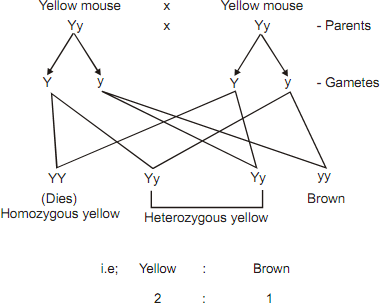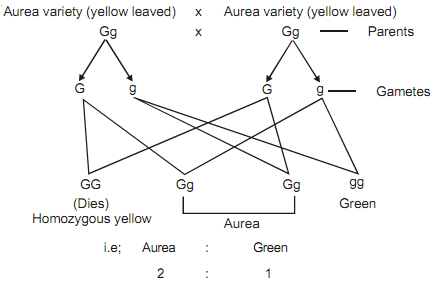LETHAL GENE (2:1 Instead of 1 : 2 : 1 or 3 : 1)
(i) All the genes present in an organism are not useful, but some of them show harmful effects and sometimes may cause death or lethality. Such factors or genes which cause death or lethality in an organism are called lethal gene or factors.
(ii) These lethal factors are fortunately present in recessive state and thus cause death only in homozygous condition. In heterozygous condition, they may cause structural changes.
(iii) Lethal factors were first of all reported in mice body colour by a French geneticist, L. Cuenot (1905). According to him, yellow mice never show true breeding and when yellow mouse is crossed with another yellow mouse, produce yellow and brown in the ratio of 2 : 1 (not 3 : 1). Yellow mouse is never present in homozygous condition.
(iv) In the following example, 'Y' is a dominant gene for body colour but is recessive for lethality and when recessive genes come in homozygous condition, death is caused (i.e; YY - dies).

(v) Lethal factors in case of plants were reported first of all in Snapdragons (Antirrhinum majus) by E. Baur (1907). (vi) In Snapdragons (Antirrhinum majus), yellow leaved (golden leaved) or 'aurea' variety never breeds true. When aurea variety is crossed with aurea, aurea and green are produced in the ratio of 2 : 1 (not 3 : 1) i.e. aurea is always heterozygous (Gg).

(vii) Here again 'G' is dominant gene for yellow colour but is simultaneously recessive for lethality and when recessive gene come in homozygous condition, death is caused (i.e; GG - dies).
Thus lethal factors cause modification of 3 : 1 ratio into 2 : 1.